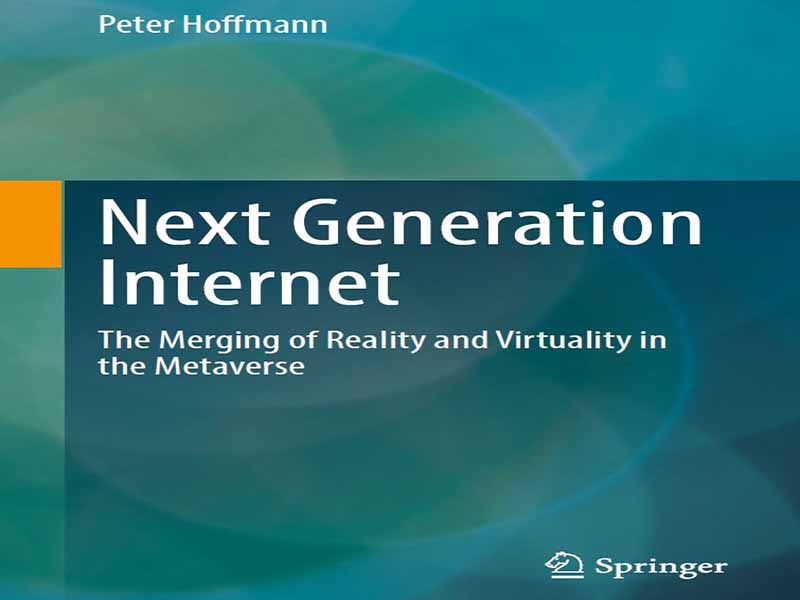- عنوان کتاب: Next Generation Internet – The Merging of Reality and Virtuality in the Metaverses
- نویسنده: Peter Hoffmann
- حوزه: اینترنت
- سال انتشار: 2025
- تعداد صفحه: 218
- زبان اصلی: انگلیسی
- نوع فایل: pdf
- حجم فایل: 3.54 مگابایت
متاورس – اصطلاحی که به طور گسترده شناخته شده و توسط بسیاری از مردم استفاده میشود. با این وجود، بحثها اغلب نشان میدهند که هر کاربر ایده شخصی خود را در مورد معنای این اصطلاح دارد. به همین دلیل، تعریف دقیق و در نظر گرفتن اصطلاح متاورس و همچنین تمام اصطلاحات مرتبط مانند واقعیت مجازی (VR)، واقعیت افزوده (AR)، واقعیت ترکیبی (MR) و واقعیت توسعهیافته ضروری است. یکی از دلایل اصلی محبوبیت اصطلاح متاورس احتمالاً این است که بخشهای بازاریابی شرکتهای بزرگ و کوچک به سرعت و بدون درک واقعی معنای آن، به این کلمه جدید روی آوردند. این شرکتها اکنون سعی میکنند از این اصطلاح برای اهداف خود استفاده کنند، که با توجه به اهمیت این اصطلاح قابل درک است، اما مدیریت اصطلاح و موضوع را پیچیده میکند. تلاشهای زیادی برای توصیف جوهره متاورس وجود دارد. چنین توصیفاتی معمولاً جذاب و جالب به نظر میرسند، اما با بررسی دقیقتر، حداقل نادرست و اغلب اشتباه هستند: شان پوری، بنیانگذار فناوری و مدیر سابق Twitch [ERL23] میگوید: «متاورس لحظهای است که زندگی دیجیتال ما بیش از زندگی فیزیکی ما ارزش دارد». چه جمله و چه بیانیهای! با این حال، این سوال مطرح میشود که آیا ما به عنوان انسانهای فیزیکی واقعاً میخواهیم زندگی فیزیکی خود را کنار بگذاریم تا منحصراً در دنیای دیجیتال حرکت کنیم. اگرچه چنین تعاریفی میتوانند برای تعامل فلسفی با متاورس مفید باشند، اما لزوماً برای تحقق متاورس مفید نیستند. حداقل آنها به طور مبهم بیان میشوند. منظور پوری این است که “در 10 تا 20 سال آینده” توجه کاربران بیشتر و بیشتر بر دنیای دیجیتال متمرکز خواهد شد تا دنیای واقعی. دلیل این امر این است که کاربران حتی بیشتر از امروز با صفحه نمایش کار یا زندگی خواهند کرد. با این حال، اغلب به نظر میرسد که به حداکثر حد خود رسیدهاند، زیرا استفاده از رسانههای اجتماعی در دستگاههای تلفن همراه مانند تلفنهای هوشمند و تبلتها باعث میشود که مردم اغلب محیط خود را فراموش کنند. “متاورس یکی از محبوبترین دنیاهای مجازی است که امروزه وجود دارد. این به کاربران اجازه میدهد تا آواتارهای خود را بسازند و محیطهای مختلف زیادی را کشف کنند. این پلتفرم صدها بازی ارائه میدهد که کاربران میتوانند بازی کنند، و همچنین هزاران فروشگاه مختلف که میتوانند چیزهای منحصر به فردی را خریداری کنند.” چنین تعاریف و تعاریف مشابهی که کاملاً واضح است که از دیدگاه بازاریابی توسعه یافتهاند، برای رویکرد پیادهسازی مفید نیستند و در واقع نادرست نیز هستند. توصیف متاورس به عنوان یکی از محبوبترین دنیاهای مجازی قطعاً میتواند مورد انتقاد قرار گیرد، زیرا متاورس به عنوان یک نهاد مستقل هنوز وجود ندارد. تنها برخی از دنیاهای مجازی مستقل مانند فورتنایت، دنیای وارکرفت و دیگران وجود دارند که از محبوبیت بسیار بالایی برخوردارند. علاوه بر این، ویژگیهای متاورس، مانند توانایی ایجاد آواتارهای شخصی و کاوش در محیطها، منحصر به فرد نیستند، بلکه مدتهاست که شناخته شدهاند و اکنون در پلتفرمهای مجازی سهبعدی متعددی تثبیت شدهاند. این گفته که متاورس صدها بازی و هزاران فروشگاه ارائه میدهد نیز باید با دید انتقادی بررسی شود، زیرا این را نمیتوان یک ویژگی خاص واقعی دانست. این امکانات مدتهاست که به سادگی و تنها از طریق اینترنت در دسترس بودهاند. در این مرحله، باید به طور منصفانه اشاره کرد که فقط بخشهای بازاریابی نیستند که اصطلاح “متاورس” را برای خود به کار میبرند. شرکتهای فناوری کوچک و بزرگ هر دو از این اصطلاح استفاده میکنند و اغلب با عجله ادعا میکنند که اکنون و در آینده “شرکتهای متاورس” هستند و در تلاشند تا متاورسهایی را برای بهبود یا گسترش واقعیت دیجیتال و فیزیکی مردم ایجاد کنند. البته، این شرکتها باید به موفقیت اقتصادی نیز دست یابند و این به آنها اعطا میشود. با این حال، با بررسی دقیقتر، مشخص میشود که این شرکتها عمدتاً در زمینههای محاسبات سهبعدی، واقعیت مجازی یا حوزههای مجاور فعال بودهاند و صرفاً در حال اضافه کردن یک برچسب جدید به سبد محصولات خود هستند. این مجاز است، اما اکنون باید با این انتقاد نیز روبرو شوند که تعریف متاورس را به این شکل پیش نمیبرند. بدون شک، اکنون میتوان مفاهیم و دیدگاههای تعریفی بسیار ناکافیتری را شناسایی کرد که با این اصطلاح به شیوهای مشابه و غیرمتعهدانه برخورد میکنند. با این حال، برای فراهم کردن ارتباط و بحث قابل اعتماد در مورد این موضوع، بخشهای زیر ابتدا تلاش میکنند تا محیط این متاورس برنامهریزی شده را تعریف کنند. هدف، ارائه یک تعریف مشخص، ملموس و پایدار در نهایت است. با این حال، ابتدا باید یک گام به عقب برداشته شود. گامی که به اینترنت امروزی منتهی میشود. اینترنت یکی از گستردهترین نوآوریهای تاریخ اخیر در سطح جهانی است. اینترنت که در دهه 1960 توسط ARPA، نهادی از وزارت دفاع ایالات متحده، به عنوان یک شبکه ارتباطی غیرمتمرکز و ایمن از شکست، تصور شد، در سال 1969 در بخش تحقیقات دانشگاهی آغاز شد. آرپانتِ آن زمان به عنوان بستری برای تبادل نتایج علمی عمل میکرد و به تدریج با گرههای اضافی و همچنین پروتکلها و برنامههای ارتباطی مناسب گسترش یافت. در دهه ۱۹۸۰، آرپانت…
The metaverse—a term that is widely known and used by many people. Nevertheless, discussions often reveal that each user has their own individual idea of what the term means. For this reason, it is essential to precisely define and consider the term metaverse as well as all related terms such as Virtual Reality (VR), Augmented Reality (AR), Mixed Reality (MR), and Extended Reality. One main reason for the popularity of the term metaverse is probably that marketing departments of large and small companies quickly jumped on this new buzzword without really understanding what it means. These companies are now trying to use the term for their own purposes, which is understandable given the importance of the term, but it complicates the handling of the term and the topic. There are many attempts to describe the essence of the metaverse. Such descriptions usually sound catchy and interesting, but upon closer inspection, they are at least inaccurate and often also wrong: “The metaverse is the moment when our digital life is worth more than our physical life” says Shaan Puri, tech founder and former Twitch manager [ERL23]. What a sentence and what a statement! However, the question arises whether we as physical humans actually want to leave our physical life behind to move exclusively in the digital world. Although such definitions can be useful for a philosophical engagement with the metaverse, they are not necessarily helpful for the realization of the metaverse. At least they are ambiguously expressed. What Puri means is that “in the next 10 to 20 years” users’ attention will focus more and more on the digital world than on the real world. This is because users will work or live with the screen even more than today. Often, however, a maximum limit seems to have already been reached, as the use of social media on mobile devices such as smartphones and tablets already makes people frequently forget their environment today. “The metaverse is one of the most popular virtual worlds that exist today. It allows users to create their own avatars and explore many different environments. The platform offers hundreds of games that users can play, as well as thousands of different stores where they can buy unique things.” Such and similar definitions, which are quite obviously developed from a marketing perspective, are not helpful for the implementation approach and are also factually inaccurate. Describing the metaverse as one of the most popular virtual worlds can certainly be criticized, as the metaverse as an independent entity does not yet exist. There are only some independent virtual worlds like Fortnite, World of Warcraft, and others that enjoy extremely high popularity. Moreover, the features of the metaverse, such as the ability to create your own avatars and explore environments, are not unique but have long been known and are now established in numerous virtual 3D platforms. The statement that the metaverse offers hundreds of games and thousands of stores should also be viewed critically, as this cannot be considered a real peculiarity. These possibilities have long been available, quite simply through the internet alone. At this point, it must be fairly pointed out that it is not only marketing departments that claim the term “metaverse” for themselves. Both small and large technology companies jump on the term and often hastily claim that they are now and in the future “metaverse companies” and are working to create metaverses to improve or expand people’s digital and physical reality. Of course, these companies must also achieve economic success, and this is to be granted to them. However, upon closer inspection, it becomes apparent that these companies were mostly already active in the fields of 3D computing, virtual reality, or adjacent areas and are merely adding a new label to their portfolio. This is allowed, but they must now also face the criticism that they are not advancing the definition of the metaverse in this way. Undoubtedly, many more equally inadequate definition concepts and perspectives could now be identified that deal with the term in a similarly non-committal manner. However, to enable reliable communication and discussion on the topic, the following sections will first attempt to define the environment of this planned metaverse. The goal is to present a concrete, tangible, and lasting definition in the end. However, a step back should first be taken here. A step that leads back to today’s internet. The internet is one of the most widespread innovations of recent history on a global level. Conceived in the 1960s by ARPA, an institution of the US Department of Defense, as a decentralized and fail-safe communication network, it began in 1969 in the academic research sector. The then ARPANET functioned as an exchange platform for scientific results and was successively expanded with additional nodes as well as suitable communication protocols and applications. In the 1980s, ARPANET transformed into a global communication network. With the development of the World Wide Web by Tim Berners- Lee in 1989 and the subsequent commercialization, the internet became an omnipresent phenomenon. Over the years, the internet has gone through various development phases and has been continuously expanded with new applications, such as “user-generated content” or social networks. The timing of the next revolutionary development remains to be seen. [BRA10] Perhaps it is just around the corner with “the metaverse.” Compared to the current internet, which has gradually built its economic, social, and cultural relevance over a period of three decades, the metaverse is also undergoing a continuous and progressive development. It could indeed be the Trojan horse that enables well-known technologies to break through into a new form of virtual world [SCHm21a].
این کتاب را میتوانید از لینک زیر بصورت رایگان دانلود کنید:
Download: Next Generation Internet




































نظرات کاربران